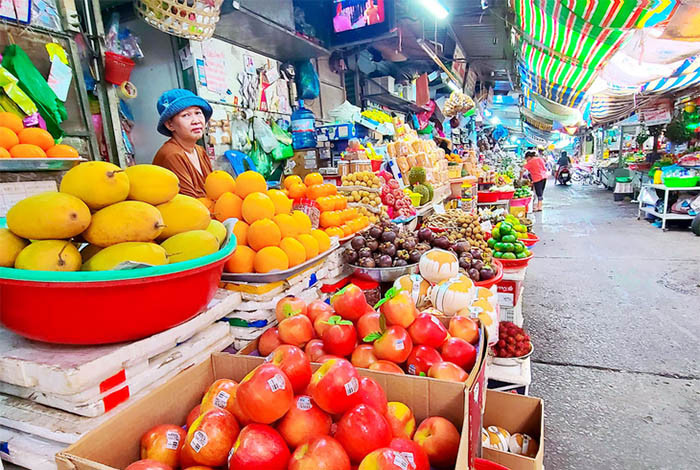Diabetics do not dare to eat sweet fruits for fear of high blood sugar, but do not know that many types of fruits that are not sweet have much higher sugar content than sweet fruits. To control blood sugar, you must calculate the glycemic load.

Should diabetics avoid fruit? - Illustration
Sweetness does not go with sugar content
Doctor Nguyen Huy Cuong, former deputy head of the diabetes department at the Central Endocrinology Hospital, said that it is completely wrong for many diabetics to abstain from eating sweet fruits.
Fresh fruit is a rich source of nutrients, including vitamins, minerals, and soluble and insoluble fiber, which are beneficial to health and cannot be replaced by foods of animal origin.
"This unfounded taboo has caused the patient's diet to become unbalanced, leading to a number of diseases caused by a lack of vitamins and minerals," Dr. Cuong emphasized.
Dr. Cuong analyzed that most of us have the perception that sweeter fruits have more sugar. But in reality, sweetness does not go hand in hand with sugar content.
For example, watermelon is sweet so most people think it has more sugar than dragon fruit but in fact it is completely opposite.
In 280g of watermelon there are 10g of sugar (including the discarded part), while 115g of dragon fruit also gives 10g of sugar, which is less than half the weight of watermelon but the same amount of sugar.
Similarly, sapodilla with apple and persimmon with grapefruit. In fact, 161g of persimmon gives 10g of sugar, and 137g of grapefruit also has 10g of sugar...
This is because depending on the type of sugar contained in the fruit, how much sugar does it contain? It will create a feeling of more or less sweetness...
If the sweetness of sucrose (sugar) is 100, then the sweetness of sugars will be as follows: fructose (sugar often found in ripe fruit) 173; glucose 74; maltose 32.5; galactose (sugar in milk) 32.1; lactose (milk sugar) 16; Chemical sugar is hundreds of times sweeter than sucrose, but in fact it is not real sugar?
The amount of sugar does not determine the sweetness of fruits or foods. From here we can see that any ripe fruit that contains a lot of fructose will taste sweeter than a fruit that contains less of this sugar (in that case the sugar will be another type of sugar such as sucrose or glucose, for example).
200ml of unsweetened fresh milk actually has 9g of lactose, but when drinking it, it doesn't taste as sweet as eating 250g of watermelon, even though both have the same amount of sugar.
Therefore, in order not to be fooled by feelings, we need to learn how to convert the actual amount of sugar in different fruits to know which fruits should be eaten more and which fruits should be eaten less.
Do you need to abstain carefully?
According to Dr. Cuong, the increase in blood sugar depends on the amount of food. Therefore, diabetics need to know how to estimate the ability of food to increase blood sugar by the glycemic load. This index is calculated as follows: take the number of grams of carbohydrates multiplied by the glycemic index divided by 100.
Glycemic index: calculated based on the same amount of sugar intake regardless of the type of food and is usually converted to 50g or 100g of sugar.
Glycemic load: calculated based on the increase in blood sugar for each type of food that we often eat in actual quantity (for example, people rarely eat 50g of honey at once).
For example: 1 tablespoon of honey has a glycemic index of 104, 17g of carbohydrates, and a glycemic load of 18. Similarly: 200g of watermelon has the following corresponding indices: 102, 17g, 17; 1 cup of orange juice: 81, 12g, 16; 1 banana 150g: 75, 27g, 20; 1 bowl of lentils: 40; 40g, 16...
If we only rely on the Glycemic Index, we would think that honey and watermelon should not be eaten because they have a high Glycemic Index, while in reality, if we eat the above meals (honey; watermelon; orange juice; banana; lentils), we will see that the amount of blood sugar will increase almost the same regardless of whether the food has a high or low Glycemic Index through measuring the Glycemic Load.
In other words, 1 tablespoon of honey causes the same increase in blood sugar as eating a medium-sized banana or drinking a glass of orange juice.
"Therefore, if you have diabetes, you do not need to be too abstinent, you can eat all kinds of fruit. But you need to pay attention to the quantity and sugar index per use and choose a reasonable time to eat to avoid sudden increase in blood sugar. It is best not to use more than 150g at a time" - Dr. Cuong advised.
According to Tuoi Tre